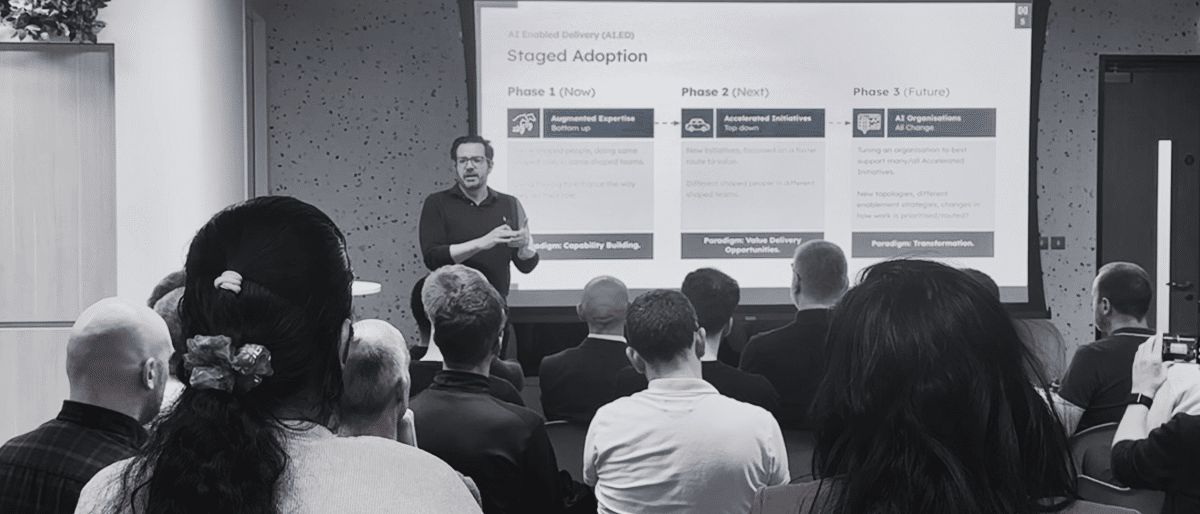It’s easy to get swept up in the promise of AI-generated code: websites springing, fully-formed from a mere idea, no reliance on those pesky developers, those long-lived roadmaps instantly satisfied — all from an endless well of boilerplate magically assembled!
But beneath the hype lies a critical truth: there is no such thing as “AI code.” Every line that ships carries human intention, oversight, and — importantly — liability.
The implications of this reality ripple across every stage of the software lifecycle. To understand what it truly means to “own” AI-assisted code, we need to examine where responsibility breaks down, how teams can structure their practices to stay in control, and what cultural shifts are needed to make AI a reliable collaborator rather than a risky shortcut.
1. Why AI has no accountability
AI models are powerful pattern-matchers trained on a vast corpora of existing code. Yet they possess no understanding of contracts, regulations, or the real-world consequences of their suggestions. When an AI-generated snippet fails a security audit, leaks sensitive data, or violates compliance standards, there’s no model to answer for it. Liability defaults to:
- Individual developers who prompted the AI and merged the code
- Leaders who set the release process and approval gates
- Organisations whose names appear on contracts and agreements
Unlike human authors, AI tools cannot hold certifications, maintain professional indemnity insurance, or appear before regulators. By design, they disclaim ownership — and responsibility — in their terms of service. AI can’t have social, contractual or legal accountability for the code, or outcomes of code, delivered.
In a commercial context, blind trust in “AI-authored” deliverables is a recipe for legal exposure and reputational damage.
2. Human ownership of AI-generated code still matters – a lot
Based on the above, individuals, teams, departments (as well as third-party delivery organisations) have to own the code, and the outcomes that they deliver.
This fundamental responsibility is precisely why the “vibe coding” approach (i.e. “give in to the vibes, embrace exponentials, and forget that the code even exists”- simply isn’t viable in a commercial setting.
(See: “The Trouble with Vibe Coding: When AI Hype Meets Real-World Software”.)
Instead, high-performing teams must adopt a disciplined partnership with AI by:
- Defining clear guardrails: Establish coding rules, architectural patterns, and security standards up front. Treat prompts like executable policy documents, not throwaway experiments.
- Curating prompts with context: Embed domain knowledge, performance budgets, and compliance constraints directly into each prompt to guide the AI toward safe, maintainable solutions.
- Reviewing every line: Integrate AI suggestions into your development pipeline so that every generated snippet undergoes thorough, continuous review—ideally in small batches or paired workflows to maximize cognitive focus.
- Measuring outcomes: Instrument generated code with the same observability, test coverage, and feedback loops you’d apply to hand-written code. Track defects, performance metrics, and user satisfaction to close the learning loop.
By owning both the prompts and the review process, teams transform AI from a black box into a predictable, accountable extension of their engineering practice.
3. Reviewing AI-generated code is different — and more valuable — than typical code review
It’s no secret: code review is often seen as the least-loved ritual in the development lifecycle. Reviewing a teammate’s pull request can feel like unpaid labor—digging through unfamiliar logic, wrestling with someone else’s naming conventions, and justifying nitpicks in comments. However, when that “someone else” is an AI model, the dynamics shift in your favor.
- It’s still your intent: AI-generated suggestions originate from the prompts you craft. You’re not critiquing a stranger’s implementation; you’re validating your own choices, assessing your own guardrails, and refining your own prompts.
- Purposeful feedback: Instead of flagging arbitrary style nits, you focus on whether the output aligns with business requirements, performance goals, and security mandates.
- Engaging collaboration: Framing reviews as a “conversation with your future self” boosts cognitive engagement. Asking “Will this handle peak load?” or “How does this integrate with our observability stack?” becomes intellectually stimulating rather than a rote chore.
- Continuous learning: Each review round deepens your understanding of both the problem domain and the AI’s strengths and limitations. Over time, you refine your prompts and patterns, creating a virtuous cycle of improvement.
By reframing AI output review as self-reflection rather than external policing, teams can turn a dreaded task into a high-value checkpoint that drives quality, consistency, and collective ownership. Ultimately it becomes an exercise of whether our processes are delivering code that we will stand behind.
Final thoughts
AI is an extraordinary tool for turbocharging development—but it doesn’t absolve us of accountability. There is no standalone “AI code”: every line is your code, governed by your prompts, reviews, and standards. Embrace AI to boost purpose and productivity — but keep ownership firmly in human hands.




